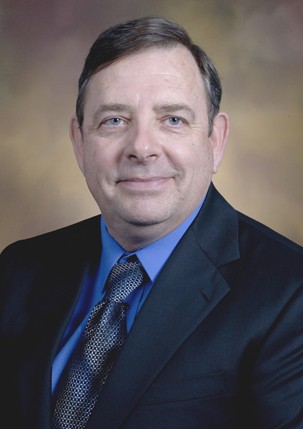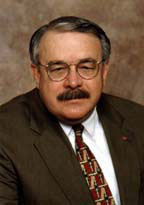Dr. David Conway of Durant was recently elected chairman of the Oklahoma Aeronautics Commission, succeeding Tulsa’s Rick Armstrong whose chairmanship ended June 30. 
Conway (shown at right) will lead the seven-member board that is responsible for encouraging, fostering and assisting in the development of aviation in Oklahoma. This includes the preservation and improvement of the Oklahoma Airport System and promotion of the state’s top employer—the aerospace industry.
Conway said that it is a privilege and an honor to serve as the Aeronautics Commission’s next chairman. "The success of our state’s aviation and aerospace industry is critical to our state’s economic future. I am looking forward to working with my fellow board members to expand and strengthen this vital industry in our state.” 

Other newly elected officers are Joe Harris of Blackwell, (shown left) vice chairman, and Dave Amis III (shown bottom right) of Oklahoma City, secretary. Besides Armstrong, the other members of the Commission include Michael Ray of Guymon; Tom Stephenson of Oklahoma City; and Wes Stucky of Ardmore. 

Conway is employed by Southeastern Oklahoma State University in Durant where he serves as director of the school’s Aviation Sciences Institute. Previously, he served as chair of the Aerospace Department and has been a member of the SOSU faculty since 1998. In 2003 he received SOSU’s Faculty Senate Award for Excellence in Service.
An avid pilot who holds commercial, instrument, CFI and multi-engine ratings, Conway retired as a command pilot from the United States Air Force where he served as an instructor pilot and evaluator pilot in the Cessna T-37 and Boeing KC-135. He is also one of a handful of flight-rated aerospace physiologists.
Conway earned his Bachelor of Science at Texas A&M – Commerce, Master of Science at the University of Southern California and Doctorate of Education from Oklahoma State University, Stillwater, and has completed coursework in human factors and physiology at specialized schools across the country, including OSU’s College of Osteopathic Medicine. He has had numerous articles published in various journals and magazines focusing on human factors in aviation. In addition, Conway recently completed three programs at Harvard University: The Art of Discussion Leadership, Management & Leadership in Education, and Crisis Leadership, as well as a fellowship in Higher Education Management at Vanderbilt University. He is currently attending Harvard’s Institute for Educational Management.
Harris, who previously served as chairman in 2008-09 during his first term on the Aeronautics Commission, has been general manager and chief executive officer of Kay Electric Cooperative for the past 23 years. Prior to his work for the electric cooperative, he served as director of Legislative and Regulatory Affairs for the Oklahoma Association of Electric Cooperatives from 1984 to 1989. He also served as assistant director for the Public Utility Division and director of Energy Conservation Services Division for the Oklahoma Corporation Commission from 1981 to 1984.
Harris’ past professional affiliations included serving as chairman of the board for the National Information Solutions Cooperative in St. Charles, Mo., and director of the Energy Co-Opportunity, Inc. Board of Directors in Washington, D.C. He also served for 10 years as chairman of the Blackwell-Tonkawa Airport Trust Authority and as a member of the Authority for 16 years. He is an active member of the Airplane Owners and Pilots Association, Experimental Aircraft Association and Antique Airplane Association.
A licensed pilot for 36 years, Harris earned a bachelor’s degree in environmental science and industrial arts from East Central University in Ada.
Amis, who is a licensed pilot with commercial, instrument and multi-engine ratings, has been involved in the aviation industry for 23 years. He is currently a program manager for PrimeWIN, an aerospace and defense business development entity. He also runs his own aviation sales and consulting firm, Vector Air, Inc.
He previously held executive positions with Arizona-based Commuter Air Technology, an aftermarket aircraft parts company, and Aero Design, Inc., an aviation-related development and consulting firm located in Oklahoma City. He also served as president and chief executive officer for the Downtown Airpark in Oklahoma City. In addition, he was director and executive vice president of Amis Construction Company, a family-owned business.
During his first two terms on the Commission, Amis was named chairman twice, including most recently in fiscal year 2006-07. He previously served as a member of the legislative committee for the National Business Aviation Association, a national organization representing the business aviation community. Amis is a graduate of Oklahoma State University with a Bachelor of Science in Engineering Technology.
Oklahoma’s aviation and aerospace industry is one of the state’s largest employers, resulting in approximately 144,000 jobs statewide. The industry yields an annual industrial output of $12.5 billion and generates an annual payroll of $5 billion. One in 11 Oklahomans derive their income from the aviation and aerospace industry with an average salary of nearly $55,000 compared to about $30,000 for the average Oklahoman.
Oklahoma is also one of seven centers in the world for the modification, maintenance, repair and overhaul of aircraft, boasting the world’s largest military aircraft repair facility, Tinker Air Force Base, and the world’s largest commercial aircraft repair facility, the American Airlines Engineering Maintenance and Engineering Center in Tulsa. In addition, Oklahoma has 111 publicly owned airports, placing it 10th nationally for the number of public airports per capita. A total of 43 of those airports are jet capable, meaning their runways are at least 5,000 feet long, the minimum distance needed by most jet aircraft to safely land or take off. Approximately 93 percent of the state’s population lives within 25 miles of an airport with a jet-capable runway.



